Vicony Tea Directory


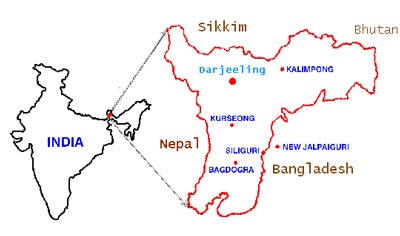 |
| Darjeeling is a name of a region in north-east India |
Darjeeling Tea(大吉岭茶)
What is the Darjeeling Tea
According to the Tea Board Of India - "Darjeeling Tea" means: tea which has been cultivated, grown, produced, manufactured and processed in tea gardens (current schedule whereof is attached hereto) in the hilly areas of Sadar Sub-Division, only hilly areas of Kalimpong Sub-Division comprising of Samabeong Tea Estate, Ambiok Tea Estate, Mission Hill Tea Estate and Kumai Tea Estate and Kurseong Sub-Division excluding the areas in jurisdiction list 20,21,23,24,29,31 and 33 comprising Subtiguri Sub-Division of New Chumta Tea Estate, Simulbari and Marionbari Tea Estate of Kurseong Police Station in Kurseong Sub-Division of the District of Darjeeling in the State of West Bengal, India. tea which has been processed and manufactured in a factory located in the aforesaid area. which, when brewed, has a distinctive, naturally occurring aroma and taste with light tea liquour and the infused leaf of which has a distinctive fragrance.
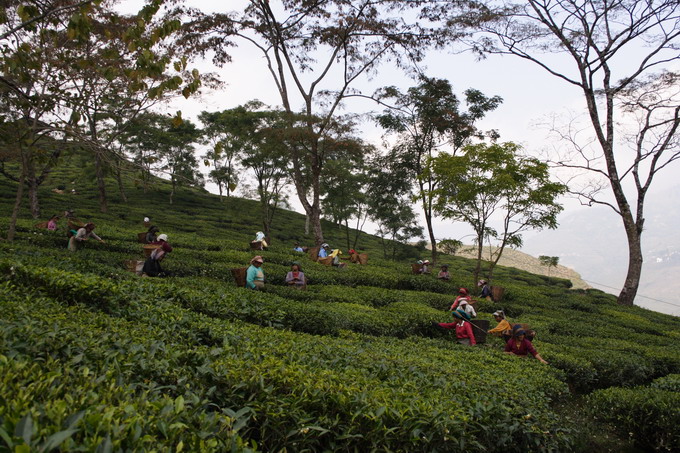
History of Darjeeling Tea
The story of Darjeeling Tea started around 1850 when a Dr. Campbell, a civil surgeon, planted tea seeds in his garden at Beechwood, Darjeeling, 7000 ft above sea level as an experiment. He was reasonably successful in raising the plant because the government, in 1847, elected to put out tea nurseries in this area.
"According to records, the first commercial tea gardens planted out by the British tea interests were Tukvar, Steinthal and Aloobari tea estates. This was in 1852 and all these plantations used seeds that were raised in the government nurseries.

"Darjeeling was then only a sparsely populated hamlet which was being used as a hill resort by the army and some affluent people. Tea, being a labour intensive enterprise, required sufficient numbers of workers to plant, tend, pluck and finally manufacture the produce. For this, employment was offered to people from across the border of Nepal.
"It appears that in 1866, Darjeeling had 39 gardens producing a total crop of 21,000 kilograms of tea. In 1870, the number of gardens increased to 56 to produce about 71,000 kgs of tea harvested from 4,400 hectares. During 1860-64, the Darjeeling Company was established with 4 gardens while the Darjeeling Consolidated Tea Co. dates back to 1896. By 1874, tea in Darjeeling was found to be a profitable venture and there were 113 gardens with approximately 6,000 hectares."
The process of Darjeeling Tea production
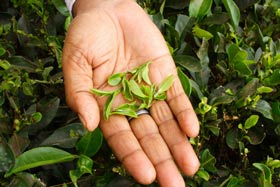 |
|
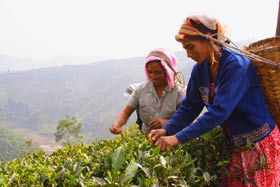 |
|
| Hand Plucking |
The Art of Plucking
Proper plucking of Darjeeling Tea leaves is as unique as its flavour. Great emphasis is given to plucking as true quality is inherent in a good raw material (Tea Leaf) and the special Darjeeling flavours is generated from the very fine plucking standard. The smallest shoots, comprising of two leaves and a bud are plucked. It requires 22,000 such shoots, all plucked by hand - to produce 1 Kg. of Tea. In attaining this high plucking standard, the hilly terrain, makes the task even more difficult.
Darjeeling Tea Pluckers have strived hard for years, battling against difficult terrain, cold, mist, rainfall etc. to maintain exacting standards. They begin early in the morning, when the overnight dew is still present. Only the tenderest leaves are finely plucked by gentle hands. Pluckers are so quick and skilful that it is often impossible to follow the motion of their hands and fingers as they pluck.
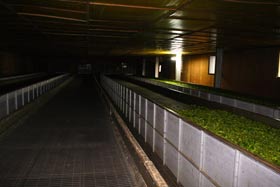 |
|
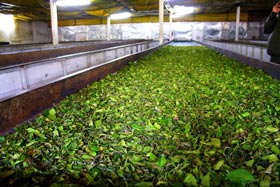 |
|
| Withering Process of Drajeeling Tea |
Withering
During this process, the green leaves are evenly spread on troughs, through which hot & cold air are blown in a regulated manner. The object is to remove moisture in the leaf slowly over a period of 14 - 16 Hours.
Rolling
The withered leaves are loaded into rollers where they are twisted by a mechanical action. The process is carefully monitored so that the style of the leaf is maintained and overheating does not take place.
Fermentation
After Rolling, the leaf is spread in a cool & humid room in very thin layers. The process lasts between 2- 4 hours, depending on temperature, humidity and leaf quality. During the process the tea develops a unique flavour and aroma. The Tea Makers sensory judgement is critical to quality of the liquor.
Drying (Firing)
The fermented leaf is taken to a dryer, where it is subjected to regulated varying temperature for a period of 20 - 30 min. The result is black tea whose moisture has been lost after natural fermentation is checked.
Sorting and packing
This is the final stage, where the tea is graded according to the size and packed in specially designed foil lined packages.
Tasting
Darjeeling Tea tasting is a refined art which necessarily encompasses a large number of variables. A taster’s palate and olfactory senses are finely sensitive and highly discriminatory. An experienced taster can identify the garden, ambient conditions of the plucking day and can even suggest adjustments in the manufacturing process. A taster uses his sharp sense of sight, smell, touch and taste while judging the quality of the tea.
A taster must also have an in-depth knowledge about the prevailing market conditions, consumer preferences and manufacturing techniques while evaluating the tea. These are endowments of birth - it would be true to say that tasters are born and not made. These natural talents, however, have to be trained and developed through long years of practice before the palate is proficient enough to register the minute differences. This is particularly true for Darjeeling Tea Tasters as the quality of tea differs from invoice to invoice and being an exclusive tea, it has no yardstick to standardise against.
It is only an excellent cup that truly cheers and taste is perceptible only by the human palate - No wonder that this craft is viewed with a tinge of awe and wonderment.
Geography of Darjeeling
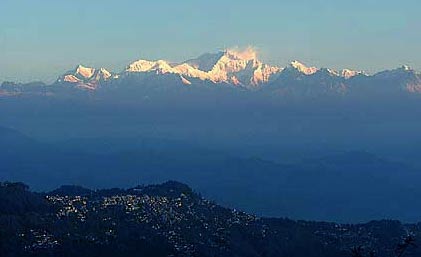 |
"The one land that all men desire to see, and having seen once by even a glimpse would not give that glimpse for the shows of the rest of the world combined." Mark Twain |
| Panoramic view from Tiger Hill with Kanchenjunga range (right) and a glimpse of Mount Everest (left) with Darjeeling town in the foreground |
Darjeeling, translated from Tibetan to mean "the land of the thunderbolt," is a priceless gem of a town in the lower Himalayas.The history of Darjeeling seemed to have begun with the establishment of a hill station by the British East India Company in 1835. Before that the region was under the subjugation of the Sikkim ruler, who after a deal with company gave them permission to develop a sanatorium for its soldiers.Once the British got hold of the region, the era of planned development began, which saw the emergence of a new hill station in the form of Darjeeling.
Darjeeling has long been known as the Queen of the Hills. The reasons are not hard to find – green, verdant hills, tea estates, the UNESCO recognized Toy Train and the smiling Gurkhas – these have long been part of the legend of Darjeeling. Once, the bustling pleasure ground of the British, Darjeeling is now thronged both by the leisure seeking family vacationers and the adventure travelers.
To the east, a dull orange sun emerged painting the sky with brilliant strokes of magenta, gold, orange and fuchsia. The snow capped Everest, Kabru, Kanchenjunga, Jannu and other peaks slowly emerge from slumber to start a new day. The sun worshippers gasp at the magnificent sight. As the fog lifts in the slowly penetrating sun, the town gradually comes alive. Amidst brewing of tea, the sing-song Gorkhali which is the local dialect, rises and falls like music.
| Green Tea | Black Tea | White Tea | Yellow Tea | Oolong Tea | Dark Tea | Pu Erh | Scented | Flowering | Herbal | Tea Powder |
| Navigation |
| Home (ViconyTeas) |
| Tea Directory (VTD) |
| Tea Importers |
| Tea Exporters |
| Tea Wholesalers |
| Informative Tea Web |
| Tea Association |
| Tea Encyclopedia |
| Online Tea Shop |
| Tea Dictionary Online |
Copyright©2016 | Darjeeling Tea
